
| 6/6 |

|
Threats to Pollinators |

| Home |
| Plan of Action |
|
Threats to pollinators and the services they provide are perceived to be increasing around the world and are largely man-made in origin [1]. Declines in pollinators have reported in several regions of Europe [2-11] and several drivers of pollinator loss have been identified: |

| Links |

| Organisation |
| Participate |
| Value of Pollinators |
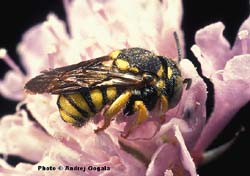
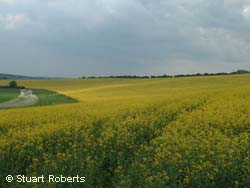
|
Habitat Loss The habitats required by many pollinators are being lost through changing land use practices such as agricultural intensification [6,10]. Pollinators require a range of resources from their environment for foraging, nesting and reproduction. The loss of any one of these requirements can cause pollinators to become locally extinct [4]. Habitats can also become fragmented and habitat patches isolated, so that pollination services are less effective [12, 13].
|

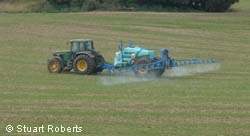
|
Agrochemicals Excessive use or inappropriate application of pesticides is known to have negative impacts on a range of pollinators [14-16].
|

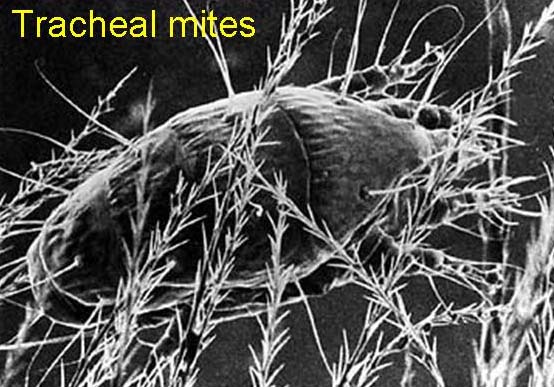
|
Parasites and Diseases European honeybees have suffered dramatic declines following the rapid spread of Varroa and tracheal mites [17, 18]; this continues as resistance to chemical control agents is increasing, and beekeeping is now also potentially at risk from the spread of the small hive beetle [19]. Bumblebees too can suffer from the spread of parasites [20].
|

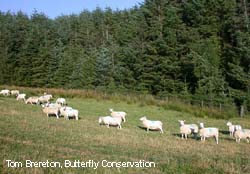
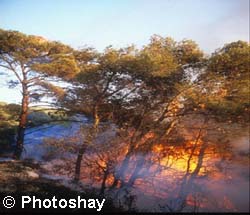
|
Fire and Overgrazing Changing fire and grazing regimes are putting increased pressure on many plant-pollinator communities, especially around the Mediterranean. More frequent fires [21] and excessive grazing [22] can lead to habitats supporting fewer pollinators.
|

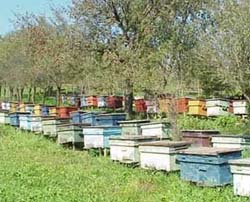
|
Competition Native or ‘wild’ pollinators can compete with managed species for floral resources [23-25]. Introducing large numbers of managed pollinators may have negative effects on local native species and knock-on effects on the plants they would normally pollinate.
|

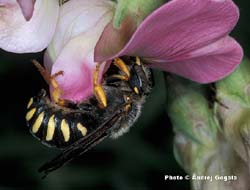
|
Climate change As climate changes, the habitats suitable for supporting pollinators may change with some areas being lost and others being newly created. When a habitat disappears, or the pollinator is unable to move to a new habitat, then local extinction can occur [26, 27].
Climate change may also disrupt the synchrony between the flowering period of plants and the activity season of pollinators [28, 29].
|

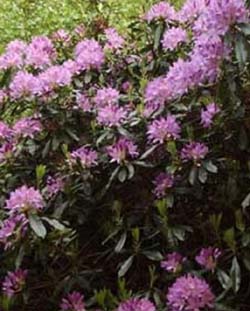
|
Introduction of non-native plants Introducing exotic plant species can have a negative impact on some pollinators. For instance, if the invading plant species comes to dominate a floral community, but does not provide the native pollinators with the resources they require, then these flower visitors will decline if no alternate resources are available [30, 31].
|

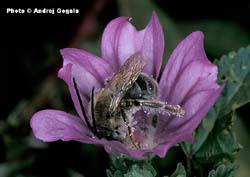
|
The future? Pollinator declines have been documented from several European localities and some of the causes of the declines been identified. Given that the drivers of loss are widespread across the continent and increasing in intensity, it is likely that the future losses of pollinators will become increasingly severe.
|

|
secretariat@EuropeanPollinatorInitiative.org European Pollinator Initiative Coordinated by: Centre for Agri-Environmental Research Reading University, PO Box 237, RG6 6AR, UK |

| Home |

| Previous |

|
References: [1] Kearns, C.A., Inouye, D.W. & Waser, N.M. (1998) Endangered mutualisms: the conservation of plant-pollinator interactions. Annual Review of Ecology and Systematics 29: 83-112. [2] Williams, P.H. (1986) Bumble bees and their decline in Britain. Central Association of Beekeepers, UK. [3] Rasmont, P. (1988) Monographie écologique et zoogéographique des bourdons de France et de Belgique (Hymenoptera, Apidae, Bombinae). PhD thesis, Faculté des Sciences Agronomique de l’Etat, Gembloux, Belgium. [4] Westrich, P. (1989) Die Wildbienen Baden-Württembergs. Stuttgart, Ulmer. [5] Corbet, S.A., Williams, I.H. & Osborne, J.L. (1991) Bees and the pollination of crops and wild flowers in the European Community. Bee World 72: 47-59. [6] Osborne, J.L., Williams, I.H. & Corbet. S.A. (1991) Bees, pollination and habitat change in the European Community. Bee World 72: 99-116. [7] Day, M.C. (1991) Towards the conservation of Aculeate Hymenoptera in Europe. Convention on the Conservation of European Wildlife and Natural Habitats. Council of Europe Press, Strasbourg, Nature and Environment Series 51. [8] Falk, S. (1991) A review of scarce and threatened bees, wasp and ants of Great Britain. Research and Survey in Nature Conservation no. 35, Nature Conservancy Council, UK. [9] O’Toole, C. (1994) Who cares for solitary bees? In: Forage for bees in an agricultural landscape, (ed A. Metheson), pp 47-56. International Bee Research Association, Cardiff, UK. [10] Banaszak, J. (1995) Changes in Fauna of Wild Bees in Europe. Pedagogical University, Bydgoszcz, Poland. [11] Williams, I.H. (1996) Aspects of bee diversity and crop pollination in the European Union. In: The Conservation of Bees (eds Matheson, A., Buchmann, S.L., O'Toole, C., Westrich, P. & Williams, I.H.), pp. 210-226. Linnaean Society Symposium Series 18. Academic Press, London, UK. [12] Jennersten, O. (1988) Pollination of Dianthus deltoides (Caryophillaceae): effects of habitat fragmentation on visitation and seed set. Conservation Biology 2: 359-366. [13] Steffan-Dewenter, I. & Tscharntke, T. (1999) Effects of habitat isolation on pollinator communities and seed set. Oecologia 121: 432-440. [14] Batra, S.W.T. (1981) Biological control in agroecosystems. Science 215: 134-139. [15] Kevan P.G. (1975) Forest application of the insecticide Fenithrothion and its effect on wild bee pollinators (Hymenoptera: Apoidea) of lowbush blueberries (Vaccinium spp.) in southern New Brunswick, Canada. Biological Conservation 7: 301-309. [16] O’Toole, C. (1993) Diversity of native bees and agroecosystems, In: Hymenoptera and Biodiversity (eds LaSalle, J. & Gauld, I.), pp. 69-106. Commonwealth Agricultural Bureau International, London, UK. [17] Williams, I.H., Corbet, S.A. & Osborne, J.L. (1991) Beekeeping, wild bees and pollination in the European Community. Bee World 72: 170-180. [18] Watanabe, M.E. (1994) Pollination worries rise as honey bees decline. Science 265: 1170. [19] Evans, J.D., Pettis, J.S., Hood, W.M., & Shimanuki, H. (2003) Tracking an invasive honey bee pest: mitochondrial DNA variation in North American small hive beetles. Apidologie 34 :103-109. [20] Schmid-Hempel, P. & Durrer, S., (1991) Parasites, floral resources and reproduction in natural populations of bumblebees. Oikos 62: 342-350. [21] Potts S.G., Vulliamy B., Dafni A., Ne’eman, G., O’Toole C., Roberts S. & Willmer P.G. (2003) Response of plant-pollinator communities following fire: changes in diversity, abundance and reward structure. Oikos 101:103-112. [22] Kreuss, A. & Tscharntke, T. (2002) Grazing intensity and the diversity of grasshoppers, butterflies, and trap nesting bees and wasps. Conservation Biology 16: 1570-1580. [23] Steffan-Dewenter, I. & Tscharntke, T. (2000) Resource overlap and possible competition between honey bees and wild bees in central Europe. Oecologia 122: 288-296. [24] Thomson, D. (2004) Competitive interactions between the invasive European honeybee and native bumblebees. Ecology 85: 458-470. [25] Butz-Huryn, V. M. (1997) Ecological impacts of introduced honey bees. The Quarterly Review of Biology 72: 275-296. [26] Travis, M.J. (2003) Climate change and habitat destruction: a deadly anthropogenic cocktail. Proceedings of the Royal Society of London (B) 270: 467-473. [27] Hill, J.K., Thomas, C.D., Fox, R., Telfer, M.G., Willis, S.G., Asher, J. & Huntley, B. (2002) Responses of butterflies to twentieth century climate warming: implications for future changes. Proceedings of the Royal Society of London (B) 269: 2163-2171. [28] Price, M.V. & Waser, N.M. (1998) Effects of experimental warming on plant reproductive phenology in a subalpine meadow. Ecology. 79: 1261-1271. [29] Wall, M.A., Timmerman-Erskine, M. & Boyd, R.S. (2003) Conservation impact of climatic variability on pollination of the federally endangered plant, Clematis socialis (Ranunculaceae). Southeastern Naturalist 2: 11-24. [30] Chittka, L. & Schürkens, S. (2001) Successful invasion of a floral market. Nature 411: 653. [31] Brown, B.J., Mitchell, R.J. & Graham, S.A. (2002) Competition for pollination between an invasive species (purple loosestrife) and a native congener. Ecology 83: 2328-2336.
|
